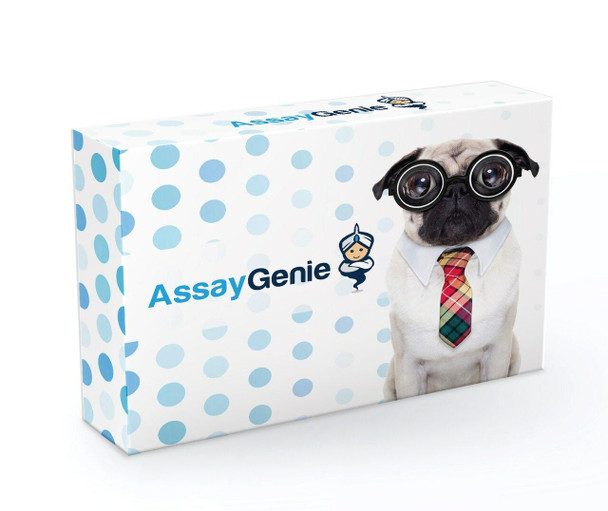Anti-RPGRIP1L Antibody (CAB18214)
- SKU:
- CAB18214
- Product type:
- Antibody
- Reactivity:
- Human
- Reactivity:
- Mouse
- Reactivity:
- Rat
- Host Species:
- Rabbit
- Isotype:
- IgG
Description
| 抗体名: | Anti-RPGRIP1L Antibody |
| 抗体コード: | CAB18214 |
| 抗体サイズ: | 20uL, 50uL, 100uL |
| 申し込み: | WB |
| 反応性: | Human, Mouse, Rat |
| 宿主種: | Rabbit |
| 免疫原: | Recombinant protein of human RPGRIP1L. |
| 申し込み: | WB |
| 推奨希釈: | WB 1:500 - 1:2000 |
| 反応性: | Human, Mouse, Rat |
| ポジティブサンプル: |
| 免疫原: | Recombinant protein of human RPGRIP1L. |
| 精製方法: | Affinity purification |
| ストレージバッファ: | Store at -20°C. Avoid freeze / thaw cycles. Buffer: PBS with 0.02% sodium azide, 50% glycerol, pH7.3. |
| アイソタイプ: | IgG |
| 順序: | Email for sequence |
| 遺伝子ID: | 23322 |
| Uniprot: | Q68CZ1 |
| セルラーロケーション: | |
| 計算された分子量: | 151kDa |
| 観察された分子量: | Refer to figures |
| 同義語: | FTM, MKS5, CORS3, JBTS7, NPHP8, PPP1R134, RPGRIP1L |
| バックグラウンド: | The protein encoded by this gene can localize to the basal body-centrosome complex or to primary cilia and centrosomes in ciliated cells. The encoded protein has been found to interact with nephrocystin-4. Defects in this gene are a cause of Joubert syndrome type 7 (JBTS7) and Meckel syndrome type 5 (MKS5). |
| UniProt Protein Function: | RPGRIP1L: Negatively regulates signaling through the G-protein coupled thromboxane A2 receptor (TBXA2R). May be involved in mechanisms like programmed cell death, craniofacial development, patterning of the limbs, and formation of the left-right axis. Involved in the organization of apical junctions in kidney cells together with NPHP1 and NPHP4. Does not seem to be strictly required for ciliogenesis. Ciliary dysfunction leads to a broad spectrum of disorders, collectively termed ciliopathies. Overlapping clinical features include retinal degeneration, renal cystic disease, skeletal abnormalities, fibrosis of various organ, and a complex range of anatomical and functional defects of the central and peripheral nervous system. The ciliopathy range of diseases includes Meckel-Gruber syndrome, Bardet-Biedl syndrome, Joubert syndrome, nephronophtisis, Senior-Loken syndrome, and Jeune asphyxiating thoracic dystrophy among others. Single-locus allelism is insufficient to explain the variable penetrance and expressivity of such disorders, leading to the suggestion that variations across multiple sites of the ciliary proteome, including RPGRIP1L, influence the clinical outcome. Defects in RPGRIP1L are the cause of Joubert syndrome type 7 (JBTS7). JBTS is an autosomal recessive disorder presenting with cerebellar ataxia, oculomotor apraxia, hypotonia, neonatal breathing abnormalities and psychomotor delay. Neuroradiologically, it is characterized by cerebellar vermis hypoplasia/aplasia, thickened and reoriented superior cerebellar peduncles, and an abnormally large interpeduncular fossa, giving the appearance of a molar tooth on transaxial slices (molar tooth sign). Additional variable features include retinal dystrophy and renal disease. Defects in RPGRIP1L are the cause of Meckel syndrome type 5 (MKS5). MKS is an autosomal recessive disorder characterized by a combination of renal cysts and variably associated features including developmental anomalies of the central nervous system (typically encephalocele), hepatic ductal dysplasia and cysts, and polydactyly. Defects in RPGRIP1L are a cause of COACH syndrome (COACHS). It is a disorder characterized by mental retardation, ataxia due to cerebellar hypoplasia, and hepatic fibrosis. Patients present the molar tooth sign, a midbrain- hindbrain malformation pathognomonic for Joubert syndrome and related disorders. Other features, such as coloboma and renal cysts, may be variable. Belongs to the RPGRIP1 family. 2 isoforms of the human protein are produced by alternative splicing. |
| UniProt Protein Details: | Chromosomal Location of Human Ortholog: 16q12.2 Cellular Component: centrosome; tight junction; cytoplasm; intercellular junction; axoneme; cytosol; cilium Molecular Function:protein binding; thromboxane A2 receptor binding Biological Process: embryonic forelimb morphogenesis; pericardium development; camera-type eye development; in utero embryonic development; negative regulation of G-protein coupled receptor protein signaling pathway; olfactory bulb development; organelle organization and biogenesis; neural tube patterning; establishment and/or maintenance of cell polarity; liver development; embryonic hindlimb morphogenesis; corpus callosum development; cerebellum development; cilium biogenesis; establishment of planar polarity; determination of left/right symmetry; kidney development; nose development; lateral ventricle development; regulation of smoothened signaling pathway Disease: Coach Syndrome; Meckel Syndrome, Type 5; Joubert Syndrome 1; Joubert Syndrome 7 |
| NCBI Summary: | The protein encoded by this gene can localize to the basal body-centrosome complex or to primary cilia and centrosomes in ciliated cells. The encoded protein has been found to interact with nephrocystin-4. Defects in this gene are a cause of Joubert syndrome type 7 (JBTS7) and Meckel syndrome type 5 (MKS5). Two transcript variants encoding different isoforms have been found for this gene. [provided by RefSeq, Jul 2008] |
| UniProt Code: | Q68CZ1 |
| NCBI GenInfo Identifier: | 296434514 |
| NCBI Gene ID: | 23322 |
| NCBI Accession: | Q68CZ1.2 |
| UniProt Secondary Accession: | Q68CZ1,Q9Y2K8, A0PJ88, |
| UniProt Related Accession: | Q68CZ1 |
| Molecular Weight: | 1315 |
| NCBI Full Name: | Protein fantom |
| NCBI Synonym Full Names: | RPGRIP1-like |
| NCBI Official Symbol: | RPGRIP1L |
| NCBI Official Synonym Symbols: | FTM; MKS5; CORS3; JBTS7; NPHP8; PPP1R134 |
| NCBI Protein Information: | protein fantom; fantom homolog; nephrocystin-8; RPGR-interacting protein 1-like protein; protein phosphatase 1, regulatory subunit 134 |
| UniProt Protein Name: | Protein fantom |
| UniProt Synonym Protein Names: | Nephrocystin-8; RPGR-interacting protein 1-like protein; RPGRIP1-like protein |
| UniProt Gene Name: | RPGRIP1L |
| UniProt Entry Name: | FTM_HUMAN |

